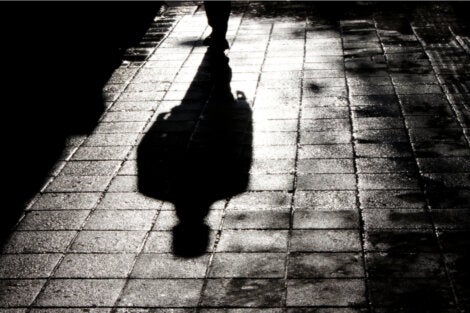Michael Stone's Scale of Evil

Forensic psychiatrist Michael Stone proposed a scale of evil that could be used to categorize criminals. So far, his scale is purely academic. In other words, forensic scientists don’t use it to classify homicides or other crimes.
In general terms, an “evil” person is someone who doesn’t feel compassion for other humans or even gets satisfaction from watching or causing other people pain. This can vary in intensity, which why the scale has different levels.
Michael Stone has a doctorate in forensic psychiatry from Columbia University. He’s dedicated a significant portion of his life to studying the behavior of killers. Ultimately, what the levels of evil measure is a criminal’s degree of psychopathy. Stone identified twenty-two levels and divided them into three groups. Let’s take a closer look.

Justifiable murder
The first category is different from the rest of the scale because it corresponds to people who kill in self-defense. Someone who’s trying to avoid getting killed is, in a sense, “indifferent” to the life of the other person, but that’s due to their survival instinct.
Evil is essentially absent in level one. Murder is the means for self-preservation, or it happens accidentally. There’s no premeditation, no intent to hurt someone else. The circumstances are responsible for the death.
The first group on the scale of evil
The first group includes categories 2 to 6 and describes murders that are committed in self-defense. The distinction here is that the murderer purposely caused the victim to suffer in some way.
These are the levels in the first group:
- Level 2. People who commit crimes of passion. They might be dangerous, but they don’t have psychopathic traits.
- Level 3. This group includes the accomplices of dangerous criminals. They might be business partners or lovers. These people tend to be antisocial, disorganized, and impulsive.
- Level 4. People who kill in self-defense, but are the ones who provoke the aggression that they then have to defend themselves from.
- Level 5. People who kill in response to sexual abuse or to get money (if they have an addiction). They aren’t psychopaths and tend to experience remorse.
- Level 6. This category includes impulsive killers who aren’t psychopaths.
The second group: psychopathic tendencies
The second group on the scale of evil includes individuals who have psychopathic traits but don’t check all the boxes for sadism. This group goes from level 7 to 16. The murders in this group are most often unjustified.
These are the levels:
- Level 7. The murderer’s motive is a narcissistic disorder that leads them to kill people for jealousy, envy, etc.
- Level 8. People who kill because of repressed anger. Here, a random trigger activates their criminal rage.
- Level 9. This category includes crimes of passion driven by a disorder of some kind.
- Level 10. People who kill for convenience. They kill whoever “gets in their way,” and their conscience is unaffected.
- Level 11. This is the same as the last, but in this case, they have a more complex psychopath profile.
- Level 12. Psychopaths who kill when they feel blocked in or trapped.
- Level 13. Psychopaths who kill out of rage on repeated occasions.
- Level 14. Psychopaths who commit premeditated crimes.
- Level 15. Serial killers who might also kill random people in a fit of rage.
- Level 16. People who commit multiple homicides.

The third group on the scale of evil: classic psychopaths
These are people who check all the boxes that describe someone as “evil” or “cruel”. In other words, they’re immune to others’ pain and are extremely anti-social.
- Level 17. Those who kill after raping someone so that their victim can’t turn them in.
- Level 18. These killers torture their victims and then murder them.
- Level 19. Not only do they want to kill, but they want to terrorize the victims the murder. They also want to terrorize the community after killing.
- Level 20. These are criminals who enjoy torturing their victims before killing them.
- Level 21. People who torture “for pleasure” but don’t always murder their victims after torturing them.
- Level 22. Torturers who do their best to prolong their victims’ suffering before killing them.
As you can see, the major distinctions in this scale are based on the intent or desire to inflict pain on other people and whether or not the criminal enjoys it. The murderer’s motive is also taken into account.
Forensic psychiatrist Michael Stone proposed a scale of evil that could be used to categorize criminals. So far, his scale is purely academic. In other words, forensic scientists don’t use it to classify homicides or other crimes.
In general terms, an “evil” person is someone who doesn’t feel compassion for other humans or even gets satisfaction from watching or causing other people pain. This can vary in intensity, which why the scale has different levels.
Michael Stone has a doctorate in forensic psychiatry from Columbia University. He’s dedicated a significant portion of his life to studying the behavior of killers. Ultimately, what the levels of evil measure is a criminal’s degree of psychopathy. Stone identified twenty-two levels and divided them into three groups. Let’s take a closer look.

Justifiable murder
The first category is different from the rest of the scale because it corresponds to people who kill in self-defense. Someone who’s trying to avoid getting killed is, in a sense, “indifferent” to the life of the other person, but that’s due to their survival instinct.
Evil is essentially absent in level one. Murder is the means for self-preservation, or it happens accidentally. There’s no premeditation, no intent to hurt someone else. The circumstances are responsible for the death.
The first group on the scale of evil
The first group includes categories 2 to 6 and describes murders that are committed in self-defense. The distinction here is that the murderer purposely caused the victim to suffer in some way.
These are the levels in the first group:
- Level 2. People who commit crimes of passion. They might be dangerous, but they don’t have psychopathic traits.
- Level 3. This group includes the accomplices of dangerous criminals. They might be business partners or lovers. These people tend to be antisocial, disorganized, and impulsive.
- Level 4. People who kill in self-defense, but are the ones who provoke the aggression that they then have to defend themselves from.
- Level 5. People who kill in response to sexual abuse or to get money (if they have an addiction). They aren’t psychopaths and tend to experience remorse.
- Level 6. This category includes impulsive killers who aren’t psychopaths.
The second group: psychopathic tendencies
The second group on the scale of evil includes individuals who have psychopathic traits but don’t check all the boxes for sadism. This group goes from level 7 to 16. The murders in this group are most often unjustified.
These are the levels:
- Level 7. The murderer’s motive is a narcissistic disorder that leads them to kill people for jealousy, envy, etc.
- Level 8. People who kill because of repressed anger. Here, a random trigger activates their criminal rage.
- Level 9. This category includes crimes of passion driven by a disorder of some kind.
- Level 10. People who kill for convenience. They kill whoever “gets in their way,” and their conscience is unaffected.
- Level 11. This is the same as the last, but in this case, they have a more complex psychopath profile.
- Level 12. Psychopaths who kill when they feel blocked in or trapped.
- Level 13. Psychopaths who kill out of rage on repeated occasions.
- Level 14. Psychopaths who commit premeditated crimes.
- Level 15. Serial killers who might also kill random people in a fit of rage.
- Level 16. People who commit multiple homicides.

The third group on the scale of evil: classic psychopaths
These are people who check all the boxes that describe someone as “evil” or “cruel”. In other words, they’re immune to others’ pain and are extremely anti-social.
- Level 17. Those who kill after raping someone so that their victim can’t turn them in.
- Level 18. These killers torture their victims and then murder them.
- Level 19. Not only do they want to kill, but they want to terrorize the victims the murder. They also want to terrorize the community after killing.
- Level 20. These are criminals who enjoy torturing their victims before killing them.
- Level 21. People who torture “for pleasure” but don’t always murder their victims after torturing them.
- Level 22. Torturers who do their best to prolong their victims’ suffering before killing them.
As you can see, the major distinctions in this scale are based on the intent or desire to inflict pain on other people and whether or not the criminal enjoys it. The murderer’s motive is also taken into account.
All cited sources were thoroughly reviewed by our team to ensure their quality, reliability, currency, and validity. The bibliography of this article was considered reliable and of academic or scientific accuracy.
Sevilla Valderas, B., & Sevilla Valderas, B. Psicoanalistas, psicólogos y psiquiatras hablan de la psicopatía y la maldad humana [Itzkowitz y Howell, 2020] Psychoanalysts, psychologists and psychiatrists discuss psychopathy and human evil [Itzkowitz and Howell, 2020].
This text is provided for informational purposes only and does not replace consultation with a professional. If in doubt, consult your specialist.







